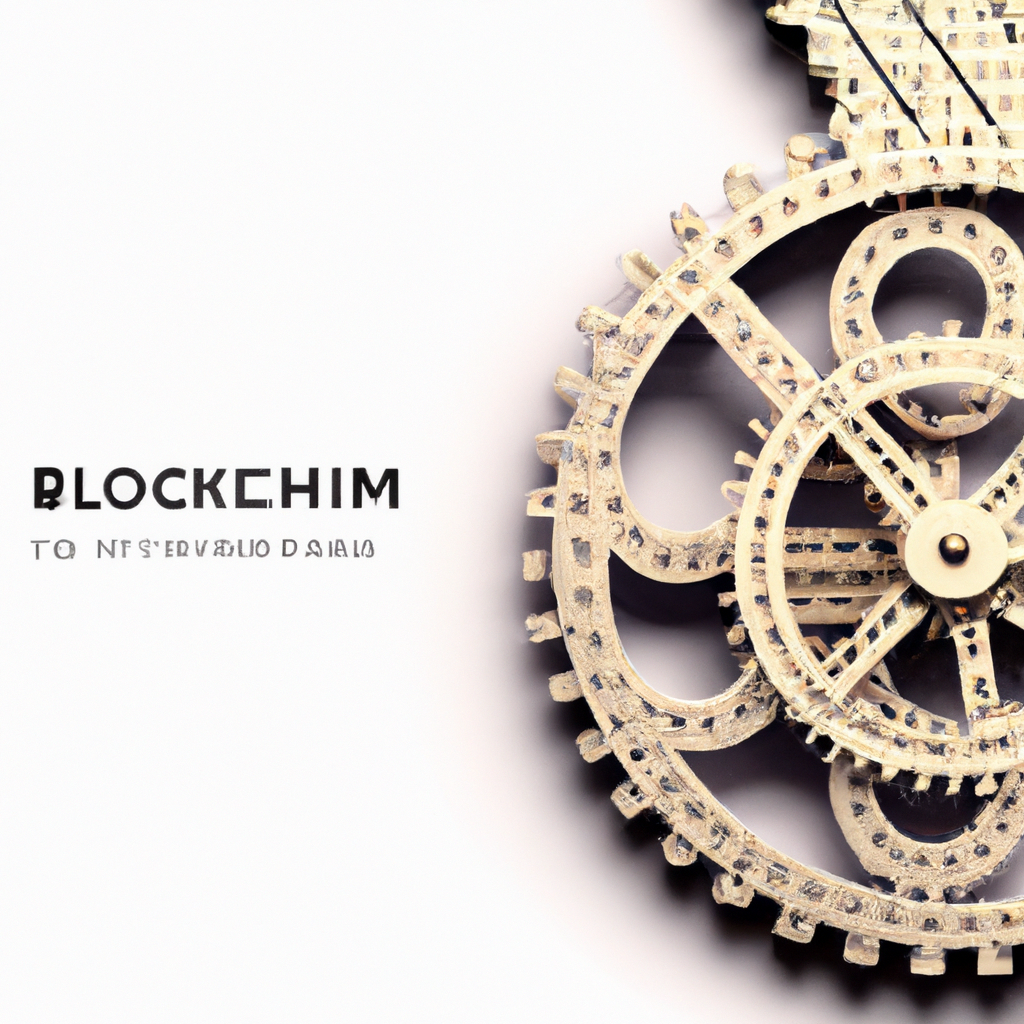In today’s rapidly evolving financial landscape, it is imperative for professionals like you to stay ahead of the curve and explore the potential of blockchain technology. As a transformative and decentralized ledger system, blockchain has the power to revolutionize the way financial transactions are conducted, offering increased transparency, security, and efficiency. This article delves into the future of finance, shedding light on the boundless possibilities that blockchain presents and the impact it is poised to have on the industry. Gain invaluable insights into how blockchain is already reshaping banking, payment systems, and cross-border transactions, and discover how you can harness its potential to unlock new opportunities for your organization.
1. The Basics of Blockchain
1.1 What is Blockchain?
Blockchain is a decentralized digital ledger that records transactions across multiple computers. It is a technology that enables the secure verification and recording of all kinds of data, not just financial transactions. The key feature of blockchain is that it is transparent and tamper-resistant, making it highly secure and reliable.
1.2 How Does Blockchain Work?
Blockchain works through a network of computers, also known as nodes, which collaborate to validate and record transactions. These transactions are grouped together into blocks, and each block is linked to the previous block, forming a chain of blocks, hence the name “blockchain.” Once a transaction is added to the blockchain, it cannot be altered or deleted, providing an immutable and transparent record of all activities.
1.3 The Key Components of Blockchain
The key components of blockchain include nodes, transactions, blocks, and consensus mechanisms. Nodes in the network validate and store transactions, which are grouped into blocks. Blocks are then linked together using cryptographic hashes. Consensus mechanisms, such as proof-of-work or proof-of-stake, ensure that all nodes agree on the validity of transactions before they are added to the blockchain.
2. Advantages of Blockchain in Finance
2.1 Enhanced Security and Trust
Blockchain provides enhanced security and trust by eliminating the need for intermediaries. Transactions are recorded on multiple nodes, making it difficult for any single party to manipulate the data. The decentralized nature of blockchain also reduces the risk of fraud and hacking, as there is no central point of failure.
2.2 Increased Efficiency
Blockchain streamlines and automates financial processes, resulting in increased efficiency. Traditional financial transactions often involve multiple intermediaries and manual processes, leading to delays and errors. With blockchain, these processes can be automated, ensuring faster and more accurate transactions.
2.3 Cost Reduction
Blockchain has the potential to significantly reduce costs in the financial industry. By eliminating the need for intermediaries and automating processes, blockchain reduces operational costs. Additionally, the transparency provided by blockchain reduces the need for audits and reconciliations, further reducing costs for financial institutions.
2.4 Transparency and Accountability
Blockchain brings transparency and accountability to financial transactions. Since all transactions are recorded on the blockchain and cannot be altered, it is easier to trace the origin and history of assets. This transparency promotes trust between parties and can help prevent fraudulent activities.

3. Transforming Financial Transactions
3.1 Streamlined Cross-Border Payments
Blockchain technology has the potential to revolutionize cross-border payments. Traditional cross-border transactions are often slow, costly, and prone to errors. By using blockchain, these transactions can be processed in real-time, with reduced fees and improved security. Blockchain also enables easier compliance with anti-money laundering and know-your-customer regulations.
3.2 Simplified Remittances
Remittance services are often expensive and complex, especially for individuals sending money to relatives in other countries. Blockchain can simplify this process by removing the need for intermediaries and reducing transaction fees. With blockchain, individuals can send and receive money directly, quickly, and at a lower cost.
3.3 Faster Settlements
Traditional settlement processes in financial markets can be time-consuming and labor-intensive. Blockchain technology can streamline settlements by enabling real-time clearing and settlement of transactions. This eliminates the need for intermediaries and reduces the settlement time from days to minutes, improving liquidity and reducing counterparty risk.
3.4 Smart Contracts
Smart contracts are self-executing agreements programmed on the blockchain. They automatically enforce the terms and conditions of the contract, eliminating the need for intermediaries and reducing the risk of disputes. Smart contracts can automate various financial transactions, such as loans, insurance claims, and supply chain financing, making them faster, more secure, and cost-effective.
4. Disintermediation in Finance
4.1 Eliminating the Need for Intermediaries
Blockchain technology has the potential to eliminate the need for intermediaries in financial transactions. By leveraging blockchain’s transparency and security, transactions can be conducted directly between parties, reducing costs and removing potential bottlenecks.
4.2 Empowering Individuals
Blockchain empowers individuals by giving them control over their financial transactions. With blockchain, individuals can manage their own digital identities, control access to their personal information, and conduct transactions without relying on traditional financial institutions. This empowerment can promote financial inclusion and provide greater financial autonomy to individuals.
4.3 Removing Middlemen Costs
Blockchain eliminates the need for middlemen in financial transactions, resulting in cost savings. Intermediaries, such as banks and payment processors, often charge fees for their services. With blockchain, these fees can be significantly reduced or eliminated altogether, allowing for more cost-effective transactions.

5. Challenges and Risks
5.1 Regulatory Uncertainty
Blockchain technology operates across borders and can be subject to different regulatory frameworks. The lack of uniform regulations poses challenges for the adoption and integration of blockchain in the financial industry. Regulators need to establish clear guidelines and frameworks to ensure the safe and compliant use of blockchain technology.
5.2 Scalability Issues
Blockchain technology currently faces scalability issues, especially in terms of transaction processing speed and capacity. As the number of transactions on the blockchain network increases, there is a need to scale the infrastructure to handle the growing demand. Scalability solutions, such as sharding and layer-two protocols, are being developed to address these challenges.
5.3 Privacy Concerns
While blockchain offers transparency, this can also raise privacy concerns. Some financial transactions require privacy and confidentiality, which may not be compatible with the transparent nature of blockchain. Efforts are being made to develop privacy-preserving solutions on the blockchain while still maintaining the security and trust that the technology provides.
5.4 Energy Consumption
One of the criticisms of blockchain technology is its high energy consumption. The process of mining, which is essential for consensus mechanisms like proof-of-work, requires significant computational power and energy. This energy-intensive nature raises environmental concerns and calls for the development of more sustainable consensus mechanisms.
6. Blockchain and Cryptocurrencies
6.1 Bitcoin and Other Cryptocurrencies
Bitcoin, the first and most well-known cryptocurrency, was built on blockchain technology. Cryptocurrencies leverage blockchain to enable secure and decentralized peer-to-peer transactions. Bitcoin and other cryptocurrencies have gained attention as alternative forms of digital currency and investments.
6.2 Central Bank Digital Currencies
Central banks are exploring the development of their own digital currencies, known as central bank digital currencies (CBDCs), using blockchain technology. CBDCs aim to provide a digital representation of a country’s fiat currency, offering the benefits of blockchain, such as faster and cheaper transactions, while still maintaining central bank control and regulation.
6.3 Stablecoins
Stablecoins are cryptocurrencies that are pegged to a stable asset, such as a fiat currency or a commodity. They aim to address the price volatility associated with cryptocurrencies like Bitcoin. Stablecoins provide a means of conducting transactions using blockchain technology while minimizing the risk associated with price fluctuations.
7. Adoption in Traditional Financial Institutions
7.1 Banks and Financial Services
Banks and financial institutions are exploring the use of blockchain technology to improve their internal processes and offer innovative services to their customers. Blockchain can streamline processes such as identity verification, cross-border payments, trade finance, and compliance. Many banks are also joining consortiums to collaborate on blockchain initiatives and establish industry standards.
7.2 Investment and Asset Management
The investment and asset management industry can benefit from blockchain’s transparency and efficiency. Blockchain can provide a secure and transparent record of ownership for assets such as stocks, bonds, and real estate. It can also streamline processes in the issuance, trading, and settlement of financial instruments, reducing costs and increasing market liquidity.
7.3 Insurance Industry
The insurance industry can leverage blockchain technology to enhance the efficiency and transparency of their processes. Blockchain can streamline claims processing, reduce fraud, and improve risk assessment. Additionally, blockchain-enabled smart contracts can automate insurance policies and claims, providing faster and more accurate settlements.
8. Applications Beyond Finance
8.1 Supply Chain Management
Blockchain has the potential to transform supply chain management by providing end-to-end visibility and traceability of goods. It can create a decentralized and transparent record of every transaction, from the sourcing of raw materials to the delivery of the final product, reducing fraud, counterfeiting, and inefficiencies in the supply chain.
8.2 Healthcare
Blockchain technology can improve the security, privacy, and interoperability of healthcare data. It enables secure sharing of patient records across healthcare providers, ensuring accurate and timely access to critical information. Blockchain can also facilitate clinical trials, supply chain logistics, and the management of medical credentials and licenses.
8.3 Voting Systems
Blockchain has the potential to enhance the integrity and transparency of voting systems. By providing a tamper-resistant and auditable record of votes, blockchain can prevent voter fraud and ensure the accuracy of election results. It can also enable remote voting and increase voter participation by providing a secure and convenient voting platform.
8.4 Intellectual Property
Blockchain can revolutionize the way intellectual property rights are managed and protected. By recording the creation, ownership, and transfer of intellectual property assets on the blockchain, it can provide an immutable and transparent record. This can streamline the process of registering patents, copyrights, and trademarks, reducing disputes and increasing trust.
9. The Future of Blockchain in Finance
9.1 Collaborative Blockchain Networks
The future of blockchain in finance is likely to involve the development of collaborative blockchain networks. These networks will allow multiple organizations to securely share data, streamline processes, and enable new business models. Consortiums and industry partnerships will play a crucial role in driving the adoption and interoperability of blockchain across the financial sector.
9.2 Integration with Emerging Technologies
Blockchain is expected to integrate with emerging technologies such as artificial intelligence, internet of things, and big data analytics. This integration will enable more advanced use cases, such as automated data analysis, predictive modeling, and smart contract execution. Blockchain’s transparency and security will enhance the reliability and trustworthiness of these emerging technologies.
9.3 Mainstream Adoption
As blockchain technology continues to mature and overcome challenges, it is expected to see mainstream adoption in the financial industry. Financial institutions will increasingly embrace blockchain to improve efficiency, transparency, and security. Regulatory frameworks will evolve to accommodate blockchain, providing a conducive environment for innovation and growth.
10. Conclusion
Blockchain technology has the potential to transform the finance industry by enhancing security, increasing efficiency, reducing costs, and promoting trust and transparency. It enables streamlined cross-border payments, simplified remittances, faster settlements, and the automation of financial contracts. While there are challenges and risks associated with blockchain adoption, such as regulatory uncertainty and scalability issues, the benefits outweigh the drawbacks. Blockchain is not limited to finance; it has applications in supply chain management, healthcare, voting systems, and intellectual property. The future of blockchain in finance lies in collaborative networks, integration with emerging technologies, and mainstream adoption. As financial institutions and regulators continue to embrace blockchain, we can expect an innovative and thriving financial ecosystem powered by this transformative technology.
